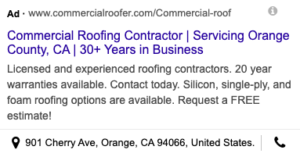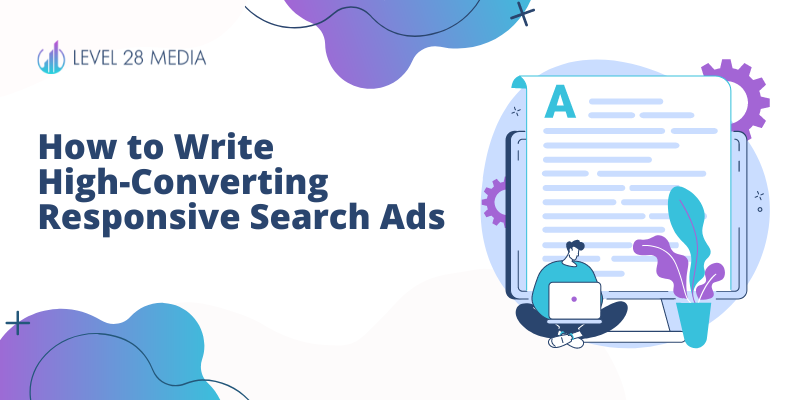With millions using Google to find the product or services they need, it is no surprise that many businesses use Google Ads as a lead generation tool. A well-designed responsive search ad campaign with compelling ads can put your business in front of the right audience at the right time when they’re looking for your service.
Compelling responsive search ads are critical to higher click-through rates and engaging traffic to become a lead. However, writing ads is often easier said than done. Google Ads only provides a limited amount of characters, so your ad copy needs to be concise and effective. In this blog, we will share best practices for creating compelling, high-converting ad copy.
Google Ads Structure & Response Search Ads
To write high-converting ad copy, you’ll first need to understand the structure of Google Ads. Extended Text Ads used to be one of the most popular ad formats in standard search campaigns, but it has since been sunsetted in mid-2022 by Google in favor of Responsive Search Ads. This gives you an advantage as you are allowed to have more headlines and descriptions.
Responsive Search Ads (RSAs) allow you to implement up to 15 headlines (30-character limit) and 4 descriptions (90-character limit). Google will then use machine learning to serve a combination of headlines and descriptions that they think will perform best.
Best Practices for Writing Google Search Ad Copy
1. Know Your Target Audience
You need to understand your target audience before you start writing any ad copy. Identify the demographics, needs, and pain points of your customer persona. Creating ad copy without an audience in mind results in generic ads that do not yield the best results.
For example, if you need to generate more leads for a swim school, your target audience would be parents. Some of their needs could be small class sizes and flexible schedules. Those would be pain points you need to address in your ads.
If your business has a few different types of customers, then you need to consider having multiple campaigns for each customer profile. The more targeted your ads are, the more they are likely to generate leads.
2. Identify Your Unique Selling Points
Remember, your ad copy is one of the first things your targeted audience will see. You want to capture their attention, so they’ll click on your ad specifically. Your ads should be able to lay out why your business is heads above the rest.
Questions to Ask:
- Is there a specific service that you offer that others do not?
- Does your experience set you apart?
- Do you have a specific certification?
- Do you offer free estimates or consultations?
For example, many roofing businesses use subcontractors. If that is something you do not do, that will help you stand apart from the competition! Or are you a med spa business that offers a specific procedure that others do not? Mention that in your ad if it’s relevant!
3. Include Your Targeted Keywords in the Ads
Conducting keyword research needs to be part of your campaign planning process. You will need to select commonly used terms by your target audience.
Once research has been completed, your targeted keywords should be placed strategically in your ad copy. However, do not stuff your ads with keywords! If your ad copy does not have your targeted keywords, you may not be able to achieve the best Quality Scores which are scores given to keywords that influence your ad rank and how much your cost-per-click will be.
If you are looking to get more commercial roofing clients, then you’ll want to use “commercial roofing contractor” in your headlines and descriptions. This will boost your Quality Score as it signals to Google that your ad is relevant to those searching specifically for commercial roofing.
Higher Quality Scores mean you’ll have more efficient costs which can lead to a lower cost per conversion! It also ensures the customer that you have exactly what they are looking for. See an example of the targeted keyword being placed in the first headline.

4. Select Your Call to Action Carefully
If your customer is enticed by your ad and is ready to take action, you need to point them in the right direction. This is why you need to include a call-to-action (CTA).
CTAs tell the customer what action they need to take to get in contact with your business. For example, a popular CTA with small businesses is Schedule an Appointment. This means that when the user clicks on the button, they will be ready to make an appointment with your business. Other examples of CTAs are:
- Call Today
- Schedule a Demo
- Claim Your Offer
Think carefully about what you want the customer to do. Should they call? Or do they need to fill out a form to sign up for a free trial or consultation? Many private practices or home services will want customers to fill out a form or call. While SaaS businesses may want users to request more information or schedule a demo.
Make sure to keep your CTAs consistent. Don’t tell the prospect to call and fill out a form. They will get confused!
5. Be Local When You Can
A very localized Google ad will be highly relevant and personalized to the end user. These prospects will feel more compelled to engage and become a lead because you are closeby to them. This is especially critical for small businesses.
Use your location in the actual ad copy. For example, “Commercial Roofer in Encino”. This will also help increase the likelihood that your ads will be served for keywords like “commercial roofer near me”. It’s also best practice to use a local phone number and location extension to increase your relevancy.

6. Use Numbers and Special Offers When Possible
Numbers will stand out in the sea of letters in ads that the customer has to scroll through. This could be in a discount, the number of customers you have served, or experience in the industry. For example, an eCommerce business should highlight its 20% discount in the headline and include the offer code in the description. A plumbing business can highlight that they have over 30+ years of combined experience.
Again, your responsive search ads should be persuasive, relay unique selling points, and resonate with your target audience. Numbers can help you convey that!

7. Test Variations of Your Ad Copy.
With RSAs being the main ad format, you can easily test more variations to see what resonates best with the customer. Use as many headlines and descriptions as possible to take up as much real estate as possible so your ads are more prominent. This will give Google’s algorithm more data to find the best combination of ad copy.
Make sure to pin the headline that has your keyword. We recommend experimenting with using unique selling points in different headlines, so you see what users gravitate to the most. Since Google combines different assets for responsive search ads, all of your headlines and descriptions make sense together. If the ad sounds off, then customers will be less likely to click on your ad!
Experimenting is key to optimizing your campaign. If you find that one CTA is gaining more traction, consider implementing it across more of your campaigns.
8. Look at Competitor Ads
Competitor analysis is key for any business, so don’t be shy about looking at what competitors are doing! You can gain a lot of insight into how people are structuring their ads and what unique selling points they are including.
You may realize that they are highlighting a specific offer or using a different CTA. This can help you understand if your ads are performing well or if you need to beef up the ad copy. Competing ads can also help serve as some inspiration if you are stuck on what to write for your ads.
Now You Are Ready to Write Responsive Search Ads!
With these best practices in your arsenal, writing Google Ad copy will be a lot easier. Remember, your ads will still need to resonate with your target audience and relay what makes your business unique in a concise way.
Looking for expert guidance on Google Ads and lead generation? Schedule a free discovery call with Level 28 Media! We’ll discuss your business needs, buyer personas, and provide a customized proposal!
Want to watch a video on this? Check it out on our YouTube channel.

Michelle Kop is a marketing consultant and award-winning pay-per-click marketing strategist. She has over 8 years of professional paid advertising experience in Google and Microsoft Ads, with a specialization in lead generation for B2B and B2C companies.
After working in corporate marketing with Fortune Global 500 Brands like Toyota and BP, Michelle founded Level 28 Media, a lead generation micro-agency for small to medium businesses.


